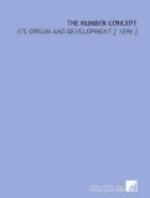Taken as a whole, the Australian and Tasmanian tribes seem to have been distinctly inferior to those of South America in their ability to use and to comprehend numerals. In all but two or three cases the Tasmanians[39] were found to be unable to proceed beyond 2; and as the foregoing examples have indicated, their Australian neighbours were but little better off. In one or two instances we do find Australian numeral scales which reach 10, and perhaps we may safely say 20. One of these is given in full in a subsequent chapter, and its structure gives rise to the suspicion that it was originally as limited as those of kindred tribes, and that it underwent a considerable development after the natives had come in contact with the Europeans. There is good reason to believe that no Australian in his wild state could ever count intelligently to 7.[40]
In certain portions of Asia, Africa, Melanesia, Polynesia, and North America, are to be found races whose number systems are almost and sometimes quite as limited as are those of the South. American and Australian tribes already cited, but nowhere else do we find these so abundant as in the two continents just mentioned, where example after example might be cited of tribes whose ability to count is circumscribed within the narrowest limits. The Veddas[41] of Ceylon have but two numerals, ekkame[=i], 1, dekkamei, 2. Beyond this they count otameekai, otameekai, otameekai, etc.; i.e. “and one more, and one more, and one more,” and so on indefinitely. The Andamans,[42] inhabitants of a group of islands in the Bay of Bengal, are equally




